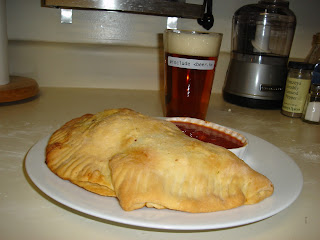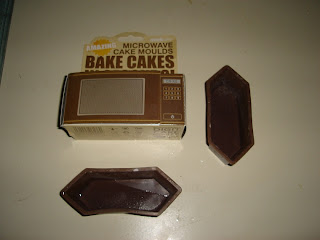I was looking forward to this week's experiment more than any other I've done so far - I love a good calzone. I did a little research on Tony and Lucille's, the reported source of the recipe. There were several mentions of this being the restuarant where calzones were invented, but I was unable to find any source. Interesting to think about anyway.
In my selection post, I'd said I wasn't going to make more than two calzones, but upon further consideration, I couldn't really see a way to cut the dough recipe in half - one package of yeast didn't seem like something I'd want to try to divide, especially since this was going to be my first experience with a raised dough. So four calzones it was to be.
When I went out to do my shopping in preparation for this week, I determined that I had no interest in spending $6 or more for three ounces of prosciutto. I found a much better deal at Costco - $8.99 for a pound, but then I'd have to use the opened package within a few days, so it would have been a waste anyway. In the end, I decided that pepperoni would be just as good to use as a filling. One other small shopping annoyance - I was going to need one pound of ricotta. The larger containers at the store are 32 ounces, so you'd think that the smaller one would be 16 oz, right? No, those are only 15 oz. I was going to be an ounce short, but that was going to be split among four calzones, so I figured it would have to be OK.
Making the dough was simple enough - dissolve the yeast in the water and olive oil, then slowly mix in the flour and salt. Actually, the recipe had a cryptic (to me) sentence that says "add the salt at the same time". At the same time as I was mixing the flour, or add it all at once? I ended up dumping it in as I was mixing in the flour. After everything was mixed, it was time to knead the dough for ten minutes. Easy enough. Then roll it up in a ball and put it in a greased bowl to rise for 90 minutes.
While the dough was rising, I baked the sausages I'd bought, then steamed the spinach. I also got the cheeses ready, spliting the ricotta into four roughly equal parts and microplaning some parmesan.
After the dough had risen to roughly double the size ...
it was time to startt assembling things. First I had to punch down the dough. Ka POW! I split it into four pieces and rolled those into balls. Each ball got rolled into an approximately nine inch circle, and then it was time for ingredients (spinach not shown).
For the spinach and sausage, I combined half of my ricotta, the sliced up sausage, the shredded mozzarella and some pepper and mixed thoroughly. Half of that mixture got placed on each circle of dough, which then got folded in half, sealed with a fork, and brushed with olive oil.
The one on the left was my first attempt, so I guess I got cocky, and the misshapen lump on the right was not quite as pretty. Oh well. These got popped into a 450 degree oven for 30 minutes. The end result ....
I used the Trader Joe's marinara as mentioned in the selection post, poured into a small ramekin and warmed up in the microwave. I served with a tasty Sierra Nevada Torpedo IPA. (And truth be told, I used the better looking calzone for the photo. I ate the sad looking one).
For the cheese and pepperoni version, the process was nearly the same, combine the ingredients (except the pepperoni) and spread on the dough. Lay the meat out on top (you can see how this would easily be done with prosciutto instead of 'ronis), fold the dough over, seal, oil, bake.
OK, so bottom line ... both versions were good, except that the crusts were a little too hard. Turns out that when kneading the dough on a floured surface, one shouldn't just keep adding flour to keep it from sticking. The recommendation I got from a chef friend is to oil the surface next time. Also, as much as I love my TJ's marinara, it wasn't quite the right sauce for this meal. Or maybe the tiny little ramekin wasn't the right vessel. No matter what, this was probably the best recipe experiment result I've had so far, and I'll definitely try making these again.
Lessons Learned - Easy on the flour, bro.
Tools needed - nothing new this week. Having the micro-planer for the parmesan was quite handy.
Skills needed - I think I did OK this week, and aside from the flour issue I wouldn't do anything differently.






















